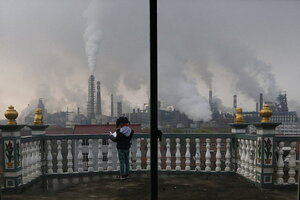Pollution in Asia tied to stronger Pacific storms that pull heat toward Arctic
The pollution comes in the form of tiny sulfate particles and black-carbon soot that result from burning coal, oil, and wood for power. The particles increase the vigor of the Pacific storms.

A girl reads a book on her balcony as smoke rises from chimneys of a steel plant on a hazy day in Quzhou, China, April 3, 2014.
Stringer/Reuters
Air pollution from Asia appears to intensify winter storms in the northwestern Pacific. In turn, these strengthened storms pull warmer air toward the Arctic and may influence the jet stream in winter, according to a new study.
The pollution comes in the form of tiny sulfate particles, black-carbon soot, and other organic-carbon particles that result from using coal and oil, as well as wood and other forms of biomass, to generate electricity, fuel vehicles, or for heating and cooking.
The particles affect the properties and behavior of cloud droplets in ways that not only increase the vigor of the storms, but trigger a buildup of thin, high-altitude cirrus clouds, say the researchers involved in the study. Cirrus clouds tend to trap heat rising from the Earth’s surface.
Researchers have studied these effects on a regional scale, notes Yuan Wang, a post-doctoral researcher at NASA's Jet Propulsion Laboratory in Pasadena, Calif., and the lead author of the study, which appears in the current issue of the Proceedings of the National Academy of Sciences.
But using a new, more-detailed approach to modeling, Dr. Wang and colleagues not only were able to put numbers to the regional effects the pollution was having on winter storms, they also were able to "better quantify the large-scale response of the atmosphere," including the increased transport of heat toward the Arctic, he says.
"This study is an important one," says Leo Donner, a researcher at the National Oceanic and Atmospheric Administration's Geophysical Fluid Dynamics Laboratory in Princeton, N.J.
It marks the first time researchers have used the new modeling approach to show a plausible link between air pollution that humans generate and the intensity of mid-latitude storm systems, he explains. Moreover, the approach the team used could help narrow longstanding and wide uncertainties about the effects of aerosols on climate – particularly their indirect effect in influencing cloud formation and behavior.
In open skies, aerosols, particularly sulfate aerosols, have a cooling effect since they reflect sunlight back toward the top of the atmosphere. But the researchers’ work supports the idea that at least for mid-latitude storms, these aerosols indirectly lead to more atmospheric warming, at least within the storms.
Aerosols serve as seeds around which cloud droplets form. As pollution levels rise, more seeds are available, allowing more droplets to form. As water vapor condenses on the seeds, it releases the heat needed to turn liquid water into a gas in the first place. This added warmth causes the air to rise, taking the droplets with it. When they rise high enough, they freeze, releasing yet more heat.
This convection intensifies at each stage, generating turbulence that will hold many droplets or ice crystals within the cloud long enough for them to gain enough heft to fall as precipitation. But a sizable portion of the ice crystals at the top of the cloud are available to be carried off ahead by high-altitude winds to form cirrus clouds.
Based on emissions scenarios from the Intergovernmental Panel on Climate Change's Fifth Assessment Report, whose third volume was released April 13, the team found that between 1850 and 2000, the average transparency of the human-generated aerosol plumes coming from Asia decreased by 46 percent, with most of that decrease centered over the northwestern Pacific. The transparency of the plumes declined by up to 108 percent at areas closest to the source of the pollution. Sulfate aerosols accounted for most of the increase.
When the researchers explored the impact of the increased aerosols on winter storms in the northern Pacific, they noted a clear increase in the amount of precipitation, evidence for more vigorous cloud-building activity, and an expansion of the area covered by cirrus clouds ahead of the storm. And they see signs of increased transport of heat toward the Arctic.
The model results were consistent with those gleaned from satellite observations and other climate modeling.
Still, "it's a cutting-edge study," says NOAA's Dr. Donner. "We're only beginning to understand how deep convective clouds are impacted by aerosols."

